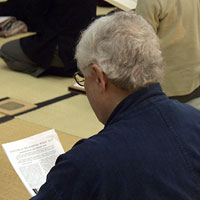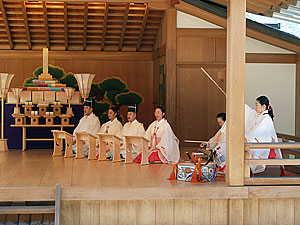
By Bill Roberts

Bill Roberts participates in annual Onisaburo reading.
On the night of Oct. 18 each year, the people of Oomoto gather to read together from the works of Onisaburo Deguchi, the Co-Founder of their religious movement. The event is quite unlike anything a Westerner might have experienced elsewhere. Everyone who attends reads aloud at the same time and from different passages. I was fortunate to attend the event this year (2001), which was the 80th anniversary of the day Onisaburo Deguchi began working on these writings.
First a little background. Oomoto, which translates as The Great Origin, has its roots in Shinto, the indigenous religion of Japan. Shinto is a collection of ancient beliefs and practices based on nature worship. Most of the Oomoto rites are variations on Shinto practices. But whereas Shinto is polytheistic, Oomoto teaches that all gods come from the same divine source—that all gods are essentially the same god. Oomoto also teaches that God is a spirit that pervades the entire universe.
In 1892, Nao Deguchi, a poor illiterate peasant woman, began to have a series of visions that would lead to the founding of Oomoto. In 1898, Onisaburo Deguchi, an educated but poor young dairy farmer, had his own ascetic experiences, which were similar to those of shamans in Central Asia and elsewhere as recorded by scholars. Onisaburo’s ascetic experiences also included prophecies similar to Nao’s revelations. The two would eventually meet and work together to build Oomoto as a religious movement.
Twenty-five years later, beginning on Oct. 18, 1821, Onisaburo Deguchi began to dictate to several scribes what would become 81 volumes (200,000 pages) of writings based on these experiences. From 1921-26 and again in 1933-34, he kept four or five scribes working daily. Oomoto was under persecution by the Japanese government at this time. Onisaburo had to keep a low profile and thus had time on his hands for this task. The writings are entitled Reikai Monogatari, or “Stories From the Spiritual World.”
In commemoration of the date that he began this task, the people of Oomoto hold a special service each Oct. 18 in the main worship hall at the Kameoka center. The event begins with a 20-minute worship service. Everyone who attends also brings a volume of “Stories From the Spiritual World.” After the worship service, at the appointed time, everyone reads out loud from the volume they brought. This cacophony of reading by a couple of hundred people continues for 30 minutes without stop. Oomoto followers elsewhere in Japan also participate, starting and ending their readings at exactly the same time we began and stopped in Kameoka.
Only a few of his writings have been translated into English. My Japanese colleagues provided me with some so I could read, too. There I was, the only non-Japanese reader, reading out loud in English with everyone else reading in Japanese. Afterwards, the grandson of Onisaburo, Kyotaro Deguchi, spoke for sometime telling stories about his grandfather.
The writings, all in the first person, are dramatic, similar in flavor to Dante’s Divine Comedy (Inferno, Purgatorio, Paradiso). Some have a Carlos Castenada feel to them, although Onisaburo was not using drugs. He was in a trance in a cave on Mount Takakuma, near Kameoka, when he had these experiences. The portions I read were more like Dante’s Inferno. An angel guides Onisaburo through the underworld. He is armed only with a special scarf, a holy wand and an incantation to protect against evil. Here’s one brief passage:
(WARNING: Not for the squeamish, but it does have a happy ending.)
“Before my eyes were a throng of women, blood pouring from their mouths, some of them impaled through the bowels with spears, others sacrificing their blood to a horde of infant vampires, still others with poisonous snakes draped around their necks. They were all raising a tremendous howl and flinging themselves about in an extremity of agony and despair. Their tormentors with bamboo spears were jabbing them in all parts of their anatomy, the blood gushing in torrents and giving off a terrible stench. A truly terrifying spectacle! I quickly shook the holy wand from left to right to left. Once, twice, three times! Their sufferings came to an end and a number of the women, in tears, gathered around me showering me with kisses.”
This passage illustrates one thing that strikes me as quite different between Onisaburo’s story and the one Dante tells. Dante only observes, never helps anyone on his journey. Onisaburo repeatedly helps people the way he does in the above passage. Another thing that differs: Dante's work had a strong political agenda, as he tells what he sees happening in hell to all the political scalliwags of Italian history. Onisaburo's work--at least the little I have read--does not have real historical characters other than the mythical gods.
The above passage notwithstanding, the few sections I have read are laced with a sense of humor. For example, in one passage Onisaburo witnesses the final judgment of mortal souls brought before the king of the underworld. He goes on for several paragraphs musing about how much easier it is to pass judgment on people without all the legal maneuverings one would find in an earthly court of law. Then Onisaburo’s spirit guide explains there’s no need for appeals or arguments because the king knows exactly what these people did and what they deserve. Onisaburo’s tone in this passage is quite humorous.
It seems to me that whatever important religious content contained in “Stories From the Spiritual World,” they also represent an important literary accomplishment.
New Contents Thu, May 20, 2010
- Oomoto participates in Sant’Egidio conference : Dialogue among religions and cultures : On divided island nation of Cyprus By Bill Roberts
- Photo Album : Portraits of three branches: Shoko, Tanegashima and Aomori By Bill Roberts
- Oomoto FAQ
- A Letter from Oomoto : Of mountains and myths By Bill Roberts
- Polyglot poem festival The Utamasturi is going international — what’s next? By Bill Roberts
- Ethics education program captures the spirit of Bankyo Dokon By Bill Roberts
- A Letter from Oomoto : A year’s worth of adventure in a summer of branch visits By Bill Roberts
- In Kumamoto, it’s all about water – and fire By Bill Roberts
- A speech by Nevada Taylor at the Kii Branch in Wakayama Prefecture on April 13, 2008.:An Encounter With Oomoto Through Aikido
- Utamatsuri, Poem Festival, in Tokyo(on April 17, 2008)
- A speech by Neil Ryan Walsh at the Kobe branch on Mar. 9th, 2008.:Planting the Seeds of the Soul
- Meeting with the Fifth Spiritual Leader of Oomoto, Madame Kurenai Deguchi by Neil Ryan Walsh
- A speech by Neil Ryan Walsh at the Nagoya branch on Feb. 17th, 2008.:The Japanese Arts beyond National Boundaries
- To the Oomoto branch in Nagoya: City of Eel and Toyota by Neil Ryan Walsh
- A Speech by Nissim Ben Shitrit, Ambassador of Israel on the occasion of the Oomoto Setsubun Grand Festival in Ayabe February 3rd, 2008 : Japan and Israel : Two Lands Balancing the Needs of Traditional Culture and Modern Life. r
- A permanent memorial to Onisaburo (A Speech at the Autumn Grand Festival , November 6, 2007 : )By James Parks Morton, Founder and Chair, Emeritus of The Interfaith Center of New York
- Israel, Palestine and the Power of Poetry(Oomoto believes small efforts can have lasting ripple effects on people and peace)By Bill Roberts
- “Something Great”(This genetics pioneer, a friend of Oomoto, offers a clue to the mystery of life)By Bill Roberts
- Kamishima Cleanup (Harima branch members regularly visit this sacred island to keep the shrine tidy)By Bill Roberts
- Kyotaro Deguchi was one of six recipients of the 2007 James Parks Morton Interfaith Award
What is Oomoto?
- What is Oomoto?
- Spirtual Centers
- Founders and Spiritual Leaders
- History
- Organization and activities
- Teachings and scriptures
- Art Works of Founders and Leaders
Opinions[Archive]
- Statement of regret for the outbreak of war against Iraq (March 20,2003)
- Jinrui Aizenkai dispatched the "Urgent Appeal for a World (Global) Crisis" on March 14.
Grappling with Bioethics[Archive]
- Oomoto’s support for abolishing the death penalty (12, June 2003)
- The Oomoto Foundation protests any birth of a human clone baby. (5, January 2003)
- OOMOTO'S VIEW REGARDING JAPAN’S PERMITION TO THE RESERCH OF HUMAN EMBRYONIC STEM CELLS (ES cells)(12, June 2000)
Vistor’s Review[Archive]
- A speech by Bill Roberts at the Oomoto branch in Hiroshima after its monthly service on March 18, 2007:Encounters with war and peace
- How Bankyo Dokon changed one life by Linda Macphee
- A speech by Bill Roberts at the Hokuriku (Kanazawa) branch on Dec. 3, 2006:Ritual and myth -an encounter with ‘divine madness’
- A speech by Bill Roberts at the Himeji Cultural Center on Feb. 25, 2007:Mesmerized by the Japanese Arts
- A speech by Bill Roberts at the Kobe branch on Feb. 11th, 2007.:There are just human tears and human joy
- A Speech on the occasion of the Oomoto Setsubun Grand Festival in Ayabe February 3rd, 2007 : Egypt's role in Middle East peace
- Keynote Speech for the 28th World Federation Japanese Religionists Conference for World Peace in Tokyo (at Kokugakuin University, Novermber 29, 2006):Vision for Peace in the Middle East By Dr. Munther S. Dajani, Professor Dean, Faculty of Arts, Al Quds University, Jerusalem
- A speech to the Kyoto branch:Spiritual adventures in researching Oomoto leaders
- A Speech at The Oomoto Foundation on Monday, November 6, 2006 : Jordan's role in Middle East By Samir Nouri, Ambassador of the Hashemite Kingdom of Jordan
- A letter from Oomoto:The Young People of Tottori
- A speech by Bill Roberts on the occasion of the dedication ceremony for the new shrine of Tottori Branch By Bill Roberts Oct. 8, 2006
- A speech by Bill Roberts at the Oomoto branch in Hiroshima after its monthly service on March 18, 2007:Encounters with war and peace
- How Bankyo Dokon changed one life by Linda Macphee
- A speech at Setsubun : A Portrait of Oomoto By Bill Roberts Feb. 3, 2006
- New Publication ! By Bill Roberts Feb. 3, 2006 A Portrait of Oomoto
you can read this book in html => http://www.jinruiaizenkai.jp/English/en-kolumno/en-bill/en-sugao/billbook1en.html
E-mail below to order brobert1@ix.netcom.com
Current Topics
- Prayer Offering and World Religious Forum II
- Living the art of dialogue
- Kyotaro Deguchi was one of six recipients of the 2007 James Parks Morton Interfaith Award
Books
Online Books
- Divine Signposts by Onisaburo DEGUCHI
- The Creation of Meaning by Hidemaru Deguchi
- Bankyo Dokon(Seventy years of Inter-Religious Activity at Oomoto)
- Nao Deguchi — A Biography of the Foundress of Oomoto
- The Great Onisaburo Deguchi published by Aiki News
- Bankyo Dokon Seventy Years of Inter-Religious Activity at Oomoto
- Insearch of Meaning
- Nao Deguchi A Biography of the Foundress of Oomoto
- A Portrait of Oomoto By Bill Roberts
Oomoto international Archive
- The History of Oomoto (Jan.– Mar. 1980 — Apr.– Jun. 1982)
- The Ancestors; Friends or Foes? (Apr.– Jun. 1987)
- Tsukinamisai; The Sabbath of Shinto (Jan.– Jun. 1983)
- The Poem Festival at Oomoto; An Ancient Rite Lives Again (Oct.– Dec. 1981)
- Purification of the Universe ; Oomoto's Setsubun Festival (Apr.– Jun. 1981)
Links
Flowers at Ten'on-kyo & Baisho-en (photographs)
Contact
All rights reserved : the Oomoto Foundation Produced by the Netinformational Commission
Since : Mar. 7.1998 Last Update : Thu, May 20, 2010
E-mail : webmaster@oomoto.or.jp
Top Page Nihongo Esperanto Português Roomazi



